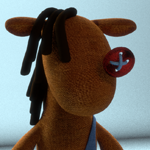I haven't ever really had any, and I feel like I'm doing something wrong in my composition. I'll listen to some of my own work, then some by Dr. Dissonance or Makkon, and it just feels like there is some piece of knowledge, some essential part of composing, that I'm missing to make it sound complete and correct.
My youtube channel is here: http://www.youtube.com/user/Coltsuke?feature=mhee
Really need critique
5 posts
• Page 1 of 1
Re: Really need critique
Kisuke wrote:some essential part of composing
Believing in yourself and making MORE music is this part of composing
[00:27:11] <@z0r8> you are voiced, now shut up
-

bartekko - Posts: 1034
- Joined: 14 Jul 2011 09:14
- Location: Poland
Re: Really need critique
Kisuke wrote:I haven't ever really had any, and I feel like I'm doing something wrong in my composition. I'll listen to some of my own work, then some by Dr. Dissonance or Makkon, and it just feels like there is some piece of knowledge, some essential part of composing, that I'm missing to make it sound complete and correct.
My youtube channel is here: http://www.youtube.com/user/Coltsuke?feature=mhee
Sounds nice and upbeat, they usually compose darker songs I recommend going into a minor key if you want darker. Also some heavier drums. I don't see anything wrong with what you have right now.

-

CGEyeGuy - Posts: 268
- Joined: 09 Dec 2011 22:13
Re: Really need critique
I'm guessing that means you like my stuff? Huzzah! 
Now, my thoughts about what you think you're "missing" after listening to Always in My (Little Pony) Heart Remastered may be something to do with variation.
Speaking for myself, when I write an arrangement of something, I tend to have the instrumentation constantly changing. The melody doesn't stay with one instrument for long! For example:
Pony Pet Labour - lets have a look at the instrumentation at the beginning shall we?
0.00 - 0.05 : Flute melody with bassoon and percussion accompaniment
0.05 - 0.07 : Fluttertongue flute with large string chords
0.07 - 0.13 : Oboe melody with bassoon, pizz strings and percussion accompaniment
0.14 - 0.15 : Same thing, but pizz strings have changed to arco (bowed)
0.16 - 0.25 : Oboe/Trumpet melody with brass, combo pizz and arco strings and percussion accompaniment. Besides Oboe, all woodwinds stop
0.25 - 0.27 : Bassoon solo with little pizz chord
SO, in approximately the first 30 seconds I have gone through 6 instrumentation changes!
In your Always in My (Little Pony) Heart Remastered, the instrumentation builds up nicely, but doesn't really change much throughout. I think that is one of the main factors, as your handling of harmony is pretty good!
Another thing is variation of the actual material. The opening harp plays this nice little motif, but it doesn't change for 43 seconds. Whilst this can be good if everything around it is constantly shifting...in this case, everything around it is not constantly shifting! It makes the piece feel rooted down on a specific chord, which is another thing I'm coming to:
Tonal center. The more it changes, the more exciting or interesting a piece is!
Back using Pony Pet Labour as an example, the piece, whilst having a fair few accidentals, is rooted down in c# minor at the beginning. Yes, the actual piece is in Db, but db minor is a stupid key and c# is easier to use, deal with it!
Here are the key changes:
0.00 - 1.16 : c# minor
1.17 - 1.49 : d# minor
1.49 - 1.58 : C# Major
1.58 - 2.47 : c# minor
2.47 - 3.18 : b minor (I think, too many accidentals are throwing me off!)
3.18 - 3.22 : B Major
3.22 - End : b minor (definitely!)
So, as you can see, in the 3.31 minutes of the piece, there are 6 key signature changes and 7 sections with different tonal centers!
And as you listen to the piece, those are just the tonal centers. I use a large amount of chords in each one as well!
I believe this is what you should consider. All orchestral music is much more varied than its more electronic cousins and that is the key to a successful orchestral piece. Well, one of the keys...variation! In everything, instrumentation, harmony, rhythm, everything! Have a think about how you can vary whatever piece you're working on at the moment more!
I am a teacher of music (all-be-it nothing fancy) in the real world and I'm always happy to offer advice and teach people stuff, so if you want any assistance, don't hesitate to ask me here, Youtube or Skype!
But for now, I've got some Steam Coal to claim!
Now, my thoughts about what you think you're "missing" after listening to Always in My (Little Pony) Heart Remastered may be something to do with variation.
Speaking for myself, when I write an arrangement of something, I tend to have the instrumentation constantly changing. The melody doesn't stay with one instrument for long! For example:
Pony Pet Labour - lets have a look at the instrumentation at the beginning shall we?
0.00 - 0.05 : Flute melody with bassoon and percussion accompaniment
0.05 - 0.07 : Fluttertongue flute with large string chords
0.07 - 0.13 : Oboe melody with bassoon, pizz strings and percussion accompaniment
0.14 - 0.15 : Same thing, but pizz strings have changed to arco (bowed)
0.16 - 0.25 : Oboe/Trumpet melody with brass, combo pizz and arco strings and percussion accompaniment. Besides Oboe, all woodwinds stop
0.25 - 0.27 : Bassoon solo with little pizz chord
SO, in approximately the first 30 seconds I have gone through 6 instrumentation changes!
In your Always in My (Little Pony) Heart Remastered, the instrumentation builds up nicely, but doesn't really change much throughout. I think that is one of the main factors, as your handling of harmony is pretty good!
Another thing is variation of the actual material. The opening harp plays this nice little motif, but it doesn't change for 43 seconds. Whilst this can be good if everything around it is constantly shifting...in this case, everything around it is not constantly shifting! It makes the piece feel rooted down on a specific chord, which is another thing I'm coming to:
Tonal center. The more it changes, the more exciting or interesting a piece is!
Back using Pony Pet Labour as an example, the piece, whilst having a fair few accidentals, is rooted down in c# minor at the beginning. Yes, the actual piece is in Db, but db minor is a stupid key and c# is easier to use, deal with it!
Here are the key changes:
0.00 - 1.16 : c# minor
1.17 - 1.49 : d# minor
1.49 - 1.58 : C# Major
1.58 - 2.47 : c# minor
2.47 - 3.18 : b minor (I think, too many accidentals are throwing me off!)
3.18 - 3.22 : B Major
3.22 - End : b minor (definitely!)
So, as you can see, in the 3.31 minutes of the piece, there are 6 key signature changes and 7 sections with different tonal centers!
And as you listen to the piece, those are just the tonal centers. I use a large amount of chords in each one as well!
I believe this is what you should consider. All orchestral music is much more varied than its more electronic cousins and that is the key to a successful orchestral piece. Well, one of the keys...variation! In everything, instrumentation, harmony, rhythm, everything! Have a think about how you can vary whatever piece you're working on at the moment more!
I am a teacher of music (all-be-it nothing fancy) in the real world and I'm always happy to offer advice and teach people stuff, so if you want any assistance, don't hesitate to ask me here, Youtube or Skype!
But for now, I've got some Steam Coal to claim!
Tubeyou
You are the hero My Little Remix deserves, not the one it needs.
So we’ll hunt you. Because you can take it. Because you’re not our hero.
You’re a silent guardian of music, a watchful protector of songs.
A doctor of dissonance.
-Phillypu
You are the hero My Little Remix deserves, not the one it needs.
So we’ll hunt you. Because you can take it. Because you’re not our hero.
You’re a silent guardian of music, a watchful protector of songs.
A doctor of dissonance.
-Phillypu
-

Dr_Dissonance - Posts: 634
- Joined: 01 Jul 2011 07:45
- Location: Australia
Re: Really need critique
This is the greatest thing I could ask for! Thank you SO much!Dr_Dissonance wrote:I'm guessing that means you like my stuff? Huzzah!
Now, my thoughts about what you think you're "missing" after listening to Always in My (Little Pony) Heart Remastered may be something to do with variation.
Speaking for myself, when I write an arrangement of something, I tend to have the instrumentation constantly changing. The melody doesn't stay with one instrument for long! For example:
Pony Pet Labour - lets have a look at the instrumentation at the beginning shall we?
0.00 - 0.05 : Flute melody with bassoon and percussion accompaniment
0.05 - 0.07 : Fluttertongue flute with large string chords
0.07 - 0.13 : Oboe melody with bassoon, pizz strings and percussion accompaniment
0.14 - 0.15 : Same thing, but pizz strings have changed to arco (bowed)
0.16 - 0.25 : Oboe/Trumpet melody with brass, combo pizz and arco strings and percussion accompaniment. Besides Oboe, all woodwinds stop
0.25 - 0.27 : Bassoon solo with little pizz chord
SO, in approximately the first 30 seconds I have gone through 6 instrumentation changes!
In your Always in My (Little Pony) Heart Remastered, the instrumentation builds up nicely, but doesn't really change much throughout. I think that is one of the main factors, as your handling of harmony is pretty good!
Another thing is variation of the actual material. The opening harp plays this nice little motif, but it doesn't change for 43 seconds. Whilst this can be good if everything around it is constantly shifting...in this case, everything around it is not constantly shifting! It makes the piece feel rooted down on a specific chord, which is another thing I'm coming to:
Tonal center. The more it changes, the more exciting or interesting a piece is!
Back using Pony Pet Labour as an example, the piece, whilst having a fair few accidentals, is rooted down in c# minor at the beginning. Yes, the actual piece is in Db, but db minor is a stupid key and c# is easier to use, deal with it!
Here are the key changes:
0.00 - 1.16 : c# minor
1.17 - 1.49 : d# minor
1.49 - 1.58 : C# Major
1.58 - 2.47 : c# minor
2.47 - 3.18 : b minor (I think, too many accidentals are throwing me off!)
3.18 - 3.22 : B Major
3.22 - End : b minor (definitely!)
So, as you can see, in the 3.31 minutes of the piece, there are 6 key signature changes and 7 sections with different tonal centers!
And as you listen to the piece, those are just the tonal centers. I use a large amount of chords in each one as well!
I believe this is what you should consider. All orchestral music is much more varied than its more electronic cousins and that is the key to a successful orchestral piece. Well, one of the keys...variation! In everything, instrumentation, harmony, rhythm, everything! Have a think about how you can vary whatever piece you're working on at the moment more!
I am a teacher of music (all-be-it nothing fancy) in the real world and I'm always happy to offer advice and teach people stuff, so if you want any assistance, don't hesitate to ask me here, Youtube or Skype!
But for now, I've got some Steam Coal to claim!
-

Kisuke - Posts: 8
- Joined: 01 Jul 2011 10:27
5 posts
• Page 1 of 1
Return to General Music Feedback and Advice
Who is online
Users browsing this forum: No registered users and 5 guests
